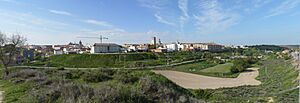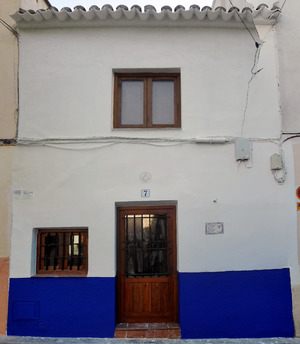Ocaña, Spain facts for kids
Quick facts for kids
Ocaña
|
|||
|---|---|---|---|

Panoramic view of Ocaña
|
|||
|
|||
| Country | Spain | ||
| Autonomous community | Castilla–La Mancha | ||
| Province | Toledo | ||
| Area | |||
| • Total | 147.9 km2 (57.1 sq mi) | ||
| Elevation | 730 m (2,400 ft) | ||
| Population
(2018)
|
|||
| • Total | 11,067 | ||
| • Density | 74.828/km2 (193.80/sq mi) | ||
| Demonym(s) | Ocañenses | ||
| Time zone | UTC+1 (CET) | ||
| • Summer (DST) | UTC+2 (CEST) | ||
| Postal code |
45300
|
||
Ocaña is a town in Spain, located in the province of Toledo, within the region of Castilla–La Mancha. It is known for its rich history and its important role as a transport hub.
Contents
What's in a Name? The Origin of Ocaña
The name Ocaña might come from an old word meaning 'fertile ground' or 'meadow'. Some experts believe it is a very ancient word from before the Romans arrived in Spain.
Ocaña's Location and Landscape
Ocaña sits on a flat area called the Mesa de Ocaña. This area is in the northeast of the province of Toledo, right in the middle of the Iberian Peninsula.
The Mesa de Ocaña is surrounded by natural features. To the north is the Tagus River. To the west are the Martín Román and Algodor rivers. To the east, it borders the Tarancón area, and to the south, it meets La Mancha. Ocaña is about 730 meters (2,400 feet) above sea level. It receives about 466 mm (18 inches) of rain each year.
A Journey Through Ocaña's History
Ocaña has a long history, dating back to Roman times. The Romans called this area Vicus Cuminarius.
Early Christian and Muslim Rule
The area around Ocaña came under Christian rule in the 11th century, likely when the city of Toledo was conquered. However, Ocaña and the land of Oreja were later taken by the Almoravids, a Muslim group. They returned to Christian control in 1139. After this, new settlements were organized starting in 1156.
The Influence of Military Orders
Two important military orders played a big role in Ocaña's history. The Order of Calatrava set up a base, called an encomienda, in Ocaña in 1176. Later, in 1182, the Order of Santiago took control of Ocaña from the Order of Calatrava. The friars of the Order of Santiago made Ocaña an important center for their order and kept control throughout the Middle Ages.
Communities and Crafts
During the 14th and 15th centuries, a Jewish community grew in Ocaña. By 1492, there were about 1,500 Jewish people living there. After this time, many people who had converted from Judaism to Christianity, known as judeoconversos, lived in Ocaña and worked as artisans.
In the early 16th century, Ocaña became a center for skilled crafts. They were especially known for making fancy perfumed gloves. However, by the end of the 16th century, the glove-making industry declined. Soap factories also became less common, but they did not disappear completely.
Ocaña also had a community of moriscos, who were Muslims who had converted to Christianity. Their numbers grew when 279 moriscos from Granada were moved to Ocaña after a conflict called the Alpujarras War. In 1610, many moriscos left the town.
The Battle of Ocaña
In 1809, after a major battle nearby called the Battle of Ocaña, the French Imperial Army took over and looted the town.
Exploring Ocaña's Main Sights
Ocaña has many interesting historical buildings and places to visit:
- Convent of Santa Catalina de Siena: A beautiful building in the Renaissance style.
- Convent of St. Dominic: Another Renaissance-style convent built between 1535 and 1605.
- Fuente Grande ("Great Spring"): A large spring built in the 16th century.
- Fuente Vieja ("Old Spring"): This spring might even have Roman origins.
- Parish church of Santa María de la Asunción: Built on the site of a 12th-century mosque.
- Parish church of St. John the Baptist: This church dates back to the 13th century.
- Convent of the Carmelites: A convent from the 16th century.
- Palacio de los Cárdenas (Cárdenas Palace): A palace built in the 16th century.
- Rollo de Justicia (Pillar of Justice): A historical pillar from the 15th century.
Ocaña as a Transportation Hub
Ocaña is a very important place for roads in Spain. Several major highways and toll roads meet here, including the A-4, A-40, R-4, and AP-36. The high-speed train line between Madrid and Levante also passes by Ocaña, though it does not have a station in the town.
Notable People from Ocaña
- Liu Zhou Linchao (born 2003), a Spanish professional footballer.
See also
 In Spanish: Ocaña (Toledo) para niños
In Spanish: Ocaña (Toledo) para niños





